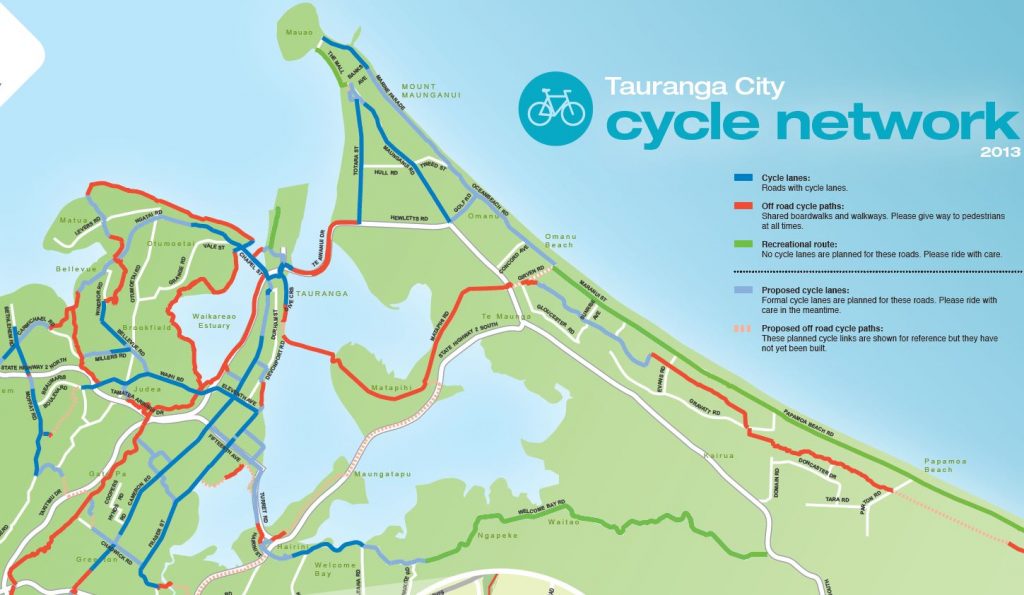Last week I spent the week in Tauranga while attending the TRAFINZ Conference, focused around local authority transport. Staying on for the weekend, I was able to have a good look around the city (which I hadn’t visited in 15 years) and see how it was doing in terms of transport and particularly cycling.
-1024x655.jpg)
Tauranga has been one of the fastest growing areas in the country for many years, with people drawn by the allure of the sunny region (ironically it rained much of the time I was there…). All that growth has put pressure on the transport networks, and there has been a huge amount of road widening and expressway building in and around the city over the past couple of decades; many people only half-jokingly have referred to it as a “mini-Auckland”. Perhaps not surprisingly that hasn’t really stemmed the tide of traffic; even a pretty decent bus network can only do so much. So there has been efforts to also develop some cycleways around the city.

Some of these cycle routes have taken advantage of the wonderful harbours and estuaries that ring the city, as well as river corridors like the Kopurererua Valley. Unfortunately, some of the afore-mentioned expressways have also found these corridors convenient locations, leading to the weird (but common) juxtaposition of cycleways and multi-lane highways next to each other.
-1024x583.jpg)
As you can see from the above map, Tauranga has a mix of on-road and off-road cycle facilities. Sometimes a route might even have both, to cater for the range of user abilities and confidence levels.
-1024x655.jpg)
The challenge with off-road facilities is often how they are dealt with at intersections, where side-roads typically have priority. Contra-flow (wrong-way) cycling can also suffer from higher crash rates due to motorists not expecting you to be there.
-1024x655.jpg)
One thing that was a very pleasant surprise were the street treatments in the central city; traffic calming and shared spaces made for a pleasant walking and biking environment downtown. Interestingly, this hadn’t been backed up with a 30km/h speed limit, which the area was crying out for.
-1024x614.jpg)
As with many cities, Tauranga suffered from the problem of doing the easy bits, but then giving up when the going got a bit tricky. This led to some gaps in coverage that might be fairly unnerving to the less confident rider.
-1024x569.jpg)
Pathway widths were also often pretty tight, particularly on supposedly shared facilities. Perhaps not a problem yet while cycle numbers are still relatively low, but some significant retrofitting might be required in due course.
-1024x569.jpg)
Ultimately, it was difficult to shake the feeling in some of the busier parts of the network that cycleways had been included to “tick the box” but were hardly going to appeal to all but the hardiest riders.
-1024x655.jpg)
Here are a few more pics from around the city:
-1024x410.jpg)
-1024x655.jpg)
-1024x569.jpg)
-1024x576.jpg)
Tauranga and neighbouring Western Bay of Plenty District have received some of the Urban Cycleway Programme funding to extend their existing cycling network. Much of it is targeted on routes around the periphery, however; there doesn’t seem to be much planning to improve the existing networks. From the relatively low use of these facilities (or the continued use of footpaths instead), it seems clear that in many places there isn’t much for the less confident rider (or would-be rider).
-1024x654.jpg)
So, definitely plenty in the “must improve” category. This was highlighted when less than 24hrs after my return, an American tourist was killed while cycling there (prompting calls to improve cycling safety); earlier in the year a 5-year-old was also killed in Tauranga riding her bike. Maybe these unfortunate incidents will be a spur for Tauranga to redouble their focus on cycling around the city.
Have you visited Tauranga? What do you think of cycling there?

-1200x768.jpg)
I am rather intrigued by the give way rule for off-road paths to side roads. Would changing this rule be a quick win for cycling? Are there any advantages to the current give-way rule?
It’s being looked at by NZTA. It might get more people cycling if councils can create off road cycleways with priority. Still need to design them well to minimise crash risk, especially for contra-flow riders. Otherwise the danger is that riders assume they have priority (and don’t check or slow) but crossing traffic still doesn’t stop/look.